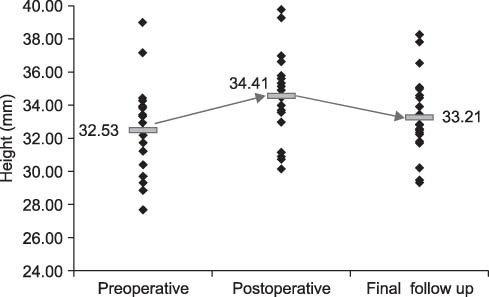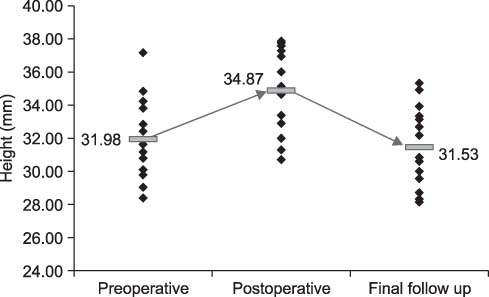J Korean Orthop Assoc.
2014 Jun;49(3):185-194.
Subsidence of Polyetheretherketone Cage after Anterior Cervical Fusion
- Affiliations
-
- 1Department of Orthopedic Surgery, Chungbuk National University School of Medicine, Cheongju, Korea. ymkim@chungbuk.ac.kr
Abstract
- PURPOSE
The purpose of this study is to evaluate the rate and direction of subsidence that occurred after anterior cervical discectomy and fusion using the polyetheretherketone (PEEK) cage and to analyze the risk factors of subsidence.
MATERIALS AND METHODS
Thirty two patients (36 segments) who underwent anterior cervical discectomy and fusion using the PEEK cage and autologous cancellous iliac bone graft from July 2003 to November 2011 were enrolled in this study. anterior segmental height (ASH), posterior segmental height (PSH) and cage corner distance (CCD) were measured on plain radiographs. Subsidence was defined as > or =2 mm decrease in the average of ASH and PSH at the final follow up compared to that measured in the immediate postoperative period. A decrease of more than 3 mm was defined as severe subsidence for further statistical analysis.
RESULTS
Subsidence of more than 2 mm was observed in 14 segments (38.9%) and severe subsidence (> or =3 mm) was observed in seven segments (19.4%). The direction of subsidence was examined by comparison of means of decreased ASH and PSH and anterior subsidence outweighed posterior subsidence (p<0.001). Examination of CCD showed that inferior subsidence was more frequent than superior subsidence (p<0.001, p=0.047). Among the suspicious risk factors for subsidence, intraoperative disc space distraction (anterior distraction: p=0.031, posterior distraction: p=0.007) and height of inserted cage (p=0.032) showed statistical significance.
CONCLUSION
Considerable incidence of subsidence was observed after use of the cage. Using a cage of appropriate height and prevention of intraoperative over-distraction of disc space will be helpful to prevention of subsidence of the cage after anterior cervical discectomy and fusion using the PEEK cage.
Figure
Reference
-
1. Cloward RB. The anterior approach for removal of ruptured cervical disks. J Neurosurg. 1958; 15:602–617.
Article2. Smith GW, Robinson RA. The treatment of certain cervical-spine disorders by anterior removal of the intervertebral disc and interbody fusion. J Bone Joint Surg Am. 1958; 40:607–624.
Article3. Sawin PD, Traynelis VC, Menezes AH. A comparative analysis of fusion rates and donor-site morbidity for autogeneic rib and iliac crest bone grafts in posterior cervical fusions. J Neurosurg. 1998; 88:255–265.
Article4. Bartels RH, Donk RD, Feuth T. Subsidence of stand-alone cervical carbon fiber cages. Neurosurgery. 2006; 58:502–508. discussion 502-8.
Article5. Cannada LK, Scherping SC, Yoo JU, Jones PK, Emery SE. Pseudoarthrosis of the cervical spine: a comparison of radiographic diagnostic measures. Spine (Phila Pa 1976). 2003; 28:46–51.6. Bartels RH, Donk R, van Azn RD. Height of cervical foramina after anterior discectomy and implantation of a carbon fiber cage. J Neurosurg. 2001; 95:40–42.
Article7. Cauthen JC, Kinard RE, Vogler JB, et al. Outcome analysis of noninstrumented anterior cervical discectomy and interbody fusion in 348 patients. Spine (Phila Pa 1976). 1998; 23:188–192.
Article8. Tribus CB, Corteen DP, Zdeblick TA. The efficacy of anterior cervical plating in the management of symptomatic pseudoarthrosis of the cervical spine. Spine (Phila Pa 1976). 1999; 24:860–864.
Article9. Geisler FH, Caspar W, Pitzen T, Johnson TA. Reoperation in patients after anterior cervical plate stabilization in degenerative disease. Spine (Phila Pa 1976). 1998; 23:911–920.
Article10. Lowery GL, McDonough RF. The significance of hardware failure in anterior cervical plate fixation. Patients with 2- to 7-year follow-up. Spine (Phila Pa 1976). 1998; 23:181–186. discussion 186-7.11. Shapiro S. Banked fibula and the locking anterior cervical plate in anterior cervical fusions following cervical discectomy. J Neurosurg. 1996; 84:161–165.
Article12. Disch AC, Schaser KD, Melcher I, et al. Oncosurgical results of multilevel thoracolumbar en-bloc spondylectomy and reconstruction with a carbon composite vertebral body replacement system. Spine (Phila Pa 1976). 2011; 36:E647–E655.
Article13. Diedrich O, Perlick L, Schmitt O, Kraft CN. Radiographic characteristics on conventional radiographs after posterior lumbar interbody fusion: comparative study between radiotranslucent and radiopaque cages. J Spinal Disord. 2001; 14:522–532.
Article14. Yang JJ, Yu CH, Chang BS, Yeom JS, Lee JH, Lee CK. Subsidence and nonunion after anterior cervical interbody fusion using a stand-alone polyetheretherketone (PEEK) cage. Clin Orthop Surg. 2011; 3:16–23.
Article15. Barsa P, Suchomel P. Factors affecting sagittal malalignment due to cage subsidence in standalone cage assisted anterior cervical fusion. Eur Spine J. 2007; 16:1395–1400.
Article16. Gercek E, Arlet V, Delisle J, Marchesi D. Subsidence of stand-alone cervical cages in anterior interbody fusion: warning. Eur Spine J. 2003; 12:513–516.
Article17. Ha SK, Park JY, Kim SH, Lim DJ, Kim SD, Lee SK. Radiologic assessment of subsidence in stand-alone cervical polyetheretherketone (PEEK) cage. J Korean Neurosurg Soc. 2008; 44:370–374.
Article18. Kast E, Derakhshani S, Bothmann M, Oberle J. Subsidence after anterior cervical inter-body fusion. A randomized prospective clinical trial. Neurosurg Rev. 2009; 32:207–214. discussion 214.
Article19. Schmieder K, Wolzik-Grossmann M, Pechlivanis I, Engelhardt M, Scholz M, Harders A. Subsidence of the wing titanium cage after anterior cervical interbody fusion: 2-year follow-up study. J Neurosurg Spine. 2006; 4:447–453.
Article20. van Jonbergen HP, Spruit M, Anderson PG, Pavlov PW. Anterior cervical interbody fusion with a titanium box cage: early radiological assessment of fusion and subsidence. Spine J. 2005; 5:645–649. discussion 649.
Article21. Shad A, Leach JC, Teddy PJ, Cadoux-Hudson TA. Use of the Solis cage and local autologous bone graft for anterior cervical discectomy and fusion: early technical experience. J Neurosurg Spine. 2005; 2:116–122.
Article22. Cheng CC, Ordway NR, Zhang X, Lu YM, Fang H, Fayyazi AH. Loss of cervical endplate integrity following minimal surface preparation. Spine (Phila Pa 1976). 2007; 32:1852–1855.
Article23. Mohammad-Shahi MH, Nikolaou VS, Giannitsios D, Ouellet J, Jarzem PF. The effect of angular mismatch between vertebral endplate and vertebral body replacement endplate on implant subsidence. J Spinal Disord Tech. 2013; 26:268–273.
Article24. Lemcke J, Al-Zain F, Meier U, Suess O. Polyetheretherketone (PEEK) spacers for anterior cervical fusion: a retrospective comparative effectiveness clinical trial. Open Orthop J. 2011; 5:348–353.
Article25. Steffen T, Tsantrizos A, Fruth I, Aebi M. Cages: designs and concepts. Eur Spine J. 2000; 9:Suppl 1. S89–S94.
Article26. Kulkarni AG, Hee HT, Wong HK. Solis cage (PEEK) for anterior cervical fusion: preliminary radiological results with emphasis on fusion and subsidence. Spine J. 2007; 7:205–209.
Article27. Cabraja M, Oezdemir S, Koeppen D, Kroppenstedt S. Anterior cervical discectomy and fusion: comparison of titanium and polyetheretherketone cages. BMC Musculoskelet Disord. 2012; 13:172.
Article28. Katsuura A, Hukuda S, Saruhashi Y, Mori K. Kyphotic malalignment after anterior cervical fusion is one of the factors promoting the degenerative process in adjacent intervertebral levels. Eur Spine J. 2001; 10:320–324.
Article29. Meier U, Kemmesies D. Experiences with six different intervertebral disc spacers for spondylodesis of the cervical spine. Orthopade. 2004; 33:1290–1299.30. Pechlivanis I, Thuring T, Brenke C, et al. Non-fusion rates in anterior cervical discectomy and implantation of empty polyetheretherketone cages. Spine (Phila Pa 1976). 2011; 36:15–20.
Article31. Moreland DB, Asch HL, Clabeaux DE, et al. Anterior cervical discectomy and fusion with implantable titanium cage: initial impressions, patient outcomes and comparison to fusion with allograft. Spine J. 2004; 4:184–191.
Article32. Link HD, McAfee PC, Pimenta L. Choosing a cervical disc replacement. Spine J. 2004; 4:294S–302S.
Article
- Full Text Links
- Actions
-
Cited
- CITED
-
- Close
- Share
- Similar articles
-
- Anterior Cervical Discectomy and Fusion Using a Stand-Alone Polyetheretherketone Cage Packed with Local Autobone : Assessment of Bone Fusion and Subsidence
- Comparison between Two Different Cervical Interbody Fusion Cages in One Level Stand-alone ACDF: Carbon Fiber Composite Frame Cage Versus Polyetheretherketone Cage
- Subsidence of Cylindrical Cage (AMSLUTM Cage): Postoperative 1 Year Follow-up of the Cervical Anterior Interbody Fusion
- Subsidence and Nonunion after Anterior Cervical Interbody Fusion Using a Stand-Alone Polyetheretherketone (PEEK) Cage
- Radiologic Assessment of Subsidence in Stand-Alone Cervical Polyetheretherketone (PEEK) Cage




